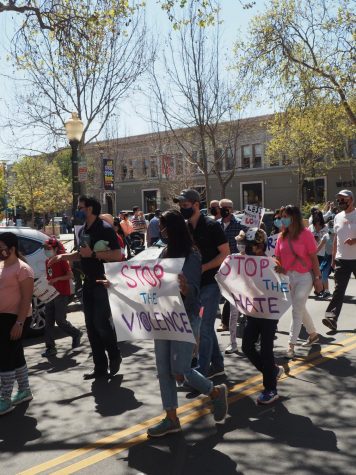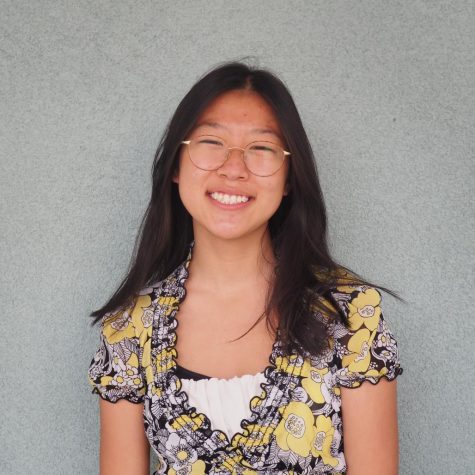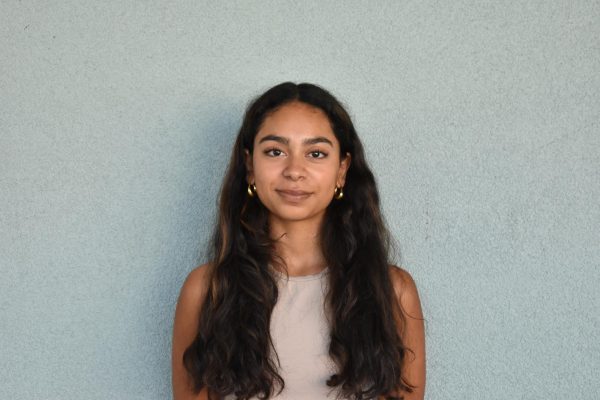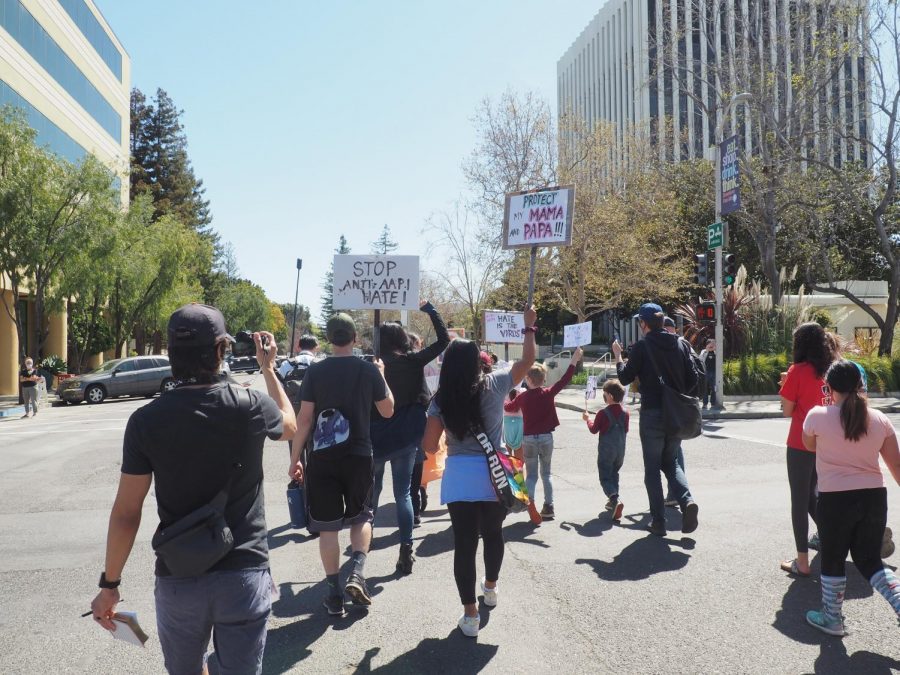Silent no longer: The Atlanta shooting and a surge in anti-Asian racism have brought Asian voices into the spotlight
Violence in Atlanta
On March 16, in Atlanta, Georgia, Robert Aaron Long drove 27 miles to three different Asian-owned massage parlors and opened fire with a 9-mm gun, murdering eight people—Delaina Ashley Yaun, Xiaojie Tan, Daoyou Feng, Paul Andre Michels, Hyun Jung Grant, Soon Chung Park, Suncha Kim, and Yong Ae Yue—and injuring another. Out of those eight, six of the victims were Asian women.
Yet in media outlets across the nation, people debated whether or not the incident was a hate crime.
In breaking news press coverage, major news outlets such as the New York Times misrepresented victims’ names, splitting up and wrongfully abbreviating Korean names. In journalist Bret Stephens’ column in the New York Times, he accused news outlets of sensationalizing the Atlanta shooting, asserting that because the shooter said the attacks weren’t racially motivated, that they must not have been. Many people were outraged by the press’s handling of the shooting, believing that the coverage diminished the racial aspect of the crime.
A spokesman for the Cherokee County Police Department, Jay Baker, referenced the crime as a result of a “bad day” for the shooter, inciting anger among the public at minimizing what many saw as an important issue. Baker, who was later removed from the case but otherwise not punished, has had a history of racism against Asian Americans, specifically against Chinese people. On Facebook, Baker promoted t-shirts with the slogan “COVID-19 imported virus from CHY-NA” multiple times in March and April of last year. “Love my shirt,” he said. “Get yours while they last.”
Events in Georgia have hit close to home for many.
In the eyes of local Palo Alto mother and Asian solidarity rally organizer Gloria Huang, the media’s downplaying of the shooting and refusal to mention race was another slap in the face. “There was a lot of silence about the recent tragedy that I didn’t expect,” Huang said. “I also saw outright denial that the shootings had anything to do with race and that almost felt like a second strike to what was happening.”
In a year that’s seen a significant increase in acts of violence and hatred against Asian Americans, the murders in Georgia were the straw that broke the camel’s back, finally pushing Asian American stories and narratives into the national spotlight. Online movements such as #StopAsianHate and #StandForAsians received larger platforms and greater support, with many celebrities and civilians alike—including NBA star Jeremy Lin, actor Steven Yeun and Nobel Peace Prize Nominee Amanda Nguyen—beginning to speak up about the Asian experience in America.
Yet despite the increase in press coverage, this year hardly marks the beginning of anti-Asian hatred in America. In reality, the history of discrimination and violence against Asian Americans runs as deeply as two centuries back—it’s only now that Asian American voices are being heard.
A History of Discrimination
When people think of Asian Americans, their minds might wander to 2018 film “Crazy Rich Asians,” stereotypical tiger moms or sitcom character London Tipton—in other words, they might imagine a relatively affluent and well-educated minority in America, and one that has only been here for a few decades. In reality, the systemic oppression of Asian people in America runs long and deep. Even before the racism caused by the coronavirus pandemic, Asians have faced discrimination for more than 200 years in America.
In 1850, whispers of striking it rich in the California gold mines brought immigrants from all over the world, including China, to America’s west coast. This was the time when Asian individuals first entered America in large numbers, but nativism—the perpetual fear and hatred of foreigners—and anger at the growing competition in the job market ultimately led to the Chinese Exclusion Act of 1882, an immigration ban prohibiting all Chinese laborers to enter the U.S. As of now, it remains one of the only immigration bans solely on the basis of nationality.
Stanford history professor and Associate Vice Provost Gordon Chang, who has researched and studied American history and published books that highlight Asian American contributions to American history, highlighted the deep-rooted nature of anti-Asian discrimination. “What history shows me is that the violence directed against Asians in America is not new, but very long-standing, and has been a part of American history from the earliest beginnings of Asian migration to the U.S.,” he said. “Violence against Asians has often been overshadowed because of the terrible violence that we know more about against Native Americans and African Americans and others, but Asian American violence has been quite terrible too. And that is not as well known.”
Chinese Americans were also the victims of one of the nation’s worst mass lynchings. On Oct. 24, 1871, around 500 white and Hispanic people entered Los Angeles’s Old Chinatown and killed 19 Chinese Americans while looting businesses and assaulting Asian citizens. The Chinese Massacre of 1871 bookmarks a painful period in American history for many Asian Americans, yet according to United States History teacher Laurel Howard, it was not an isolated incident. “[A mob] lynched 19 different Chinese people who were just caught in the wrong place at the wrong time,” she said. “But that’s just one example. Up to 200 different Chinatowns across the West all faced violence in the late 19th century.”
As a result of occupational and geographic immobility, Asian immigrants were often forced to live in ethnic enclaves, squeezed into tight spaces that became unsanitary due to lack of state funding for public services, creating the stereotype that Chinatowns were more susceptible to disease.
Howard wrote her thesis in college about how diseases were often used against immigrant communities. “In the 19th century, before we understood a lot about how disease spreads, it was really easy to look at a lot of immigrant communities getting sick and say that they were getting sick because they were immigrants,” Howard said. “There’s nothing about your ethnicity that makes you more vulnerable to a certain disease, but that association still remains for us; the fear of the outside and the fear of illness tends to combine together.”
Later, during World War II, worries that Japanese Americans would betray the U.S. war effort prompted then-President Franklin Roosevelt to send hundreds of thousands of Japanese American families to internment camps along the Pacific coast. Many were uprooted from their businesses and homes, staying in the camps with minimal belongings and poor conditions for over five years. “In the aftermath of the internment camps, all of these people don’t really have a place to go anymore because their businesses, their farms and their households have been empty for three to four years,” Howard said. “This marks a massive redistribution of wealth.”
Palo Alto City Councilmember Greg Tanaka’s family has suffered greatly at the hands of anti-Asian discrimination. His great-grandfather died of tuberculosis in an internment camp, and when his family was released, they’d lost all of their belongings and assets. Many Japanese families faced the same situation: Internment camps tore down any financial stability that Japanese immigrants had worked so hard to build. “My dad lost his dad and then his family when he got out of the camps,” Tanaka said. “The whole business was gone, right? Because you’re basically in prison for five years.”
Even Asian Americans whose grandparents are native to America may find it difficult to stop being perceived as perpetual foreigners in their home country. When World War II came around, Tanaka’s father—an American who knew no other home—felt as if he had to prove his loyalty to America. “My dad signed up for the Marines, and he served the country as well as his brother,” Tanaka said. “They put life on the line for the country, because they wanted to prove that they were good Americans.”
The Asian experience in America is not only limited to violence and tragedy, yet history books often overlook Asian-led accomplishments or achievements. Gunn 2016 alumna Shawna Chen, a volunteer Editorial Director at the Yappie, a news publication reporting on Asian power, politics and influence, noted that even when she was learning about American history in high school, she rarely felt represented in textbooks or curriculum. “I only remember two times that I felt represented in U.S. history,” she said. “The first was when I read one line in my textbook about Chinese laborers building the transcontinental railroad, and it didn’t say anything about the kind of exploitation or abuse they faced—just said that they contributed. The second was one paragraph about Japanese incarceration during World War II, and again, it didn’t really talk about how much people suffered, or how it hurt.”

Racism During COVID-19
With the COVID-19 pandemic killing more than 500 thousand people in America, anti-Asian hate crimes have become more widespread, especially in places with a higher proportion of Asian residents, such as New York and the Bay Area.
Since March 2020, marking the start of the COVID-19 lockdown in America, hate crimes against Asians have increased by nearly 150% in America’s major cities, despite overall hate crimes dropping by 7%. NBC News reported that hate crimes more than doubled from 2019 to 2020 in major cities, making a total of 122 just last year alone.
In Feb. 2021, a 36-year-old Asian man was stabbed in the back while walking in New York City’s Chinatown. On Jan. 28, 2021, Vicha Ratanapakdee, an 84-year old Thai man, was violently pushed down while taking his routine hour-long stroll through his neighborhood in San Francisco, and later died from his injuries. On Jan. 31, a 91-year-old Asian man was shoved to the ground by a teenager in Oakland’s Chinatown, who was suspected to have attacked two other Asian elderly on the same day. In March of this year, an Asian woman was sexually assaulted in a San Jose train station; her assaulter was reported to have yelled racial slurs targeted at Asian people at her before a bystander intervened. Across many major cities, scapegoating Asians for the pandemic has turned into cases of violence and murder.
Along with physical violence, reports of verbal abuse have also increased in the past year. The Stop Asian American and Pacific Islander (AAPI) Hate Reporting Center recorded 2,808 anti-Asian incidents from March to December of 2020. 70.9% of these cases were verbal harassment complaints, ranging from racial slurs to targeted COVID-19 affronts. Other reported attacks such as spitting or coughing on people have also increased in the past year.
This increase in violence and verbal abuse stems from the fact that many American citizens blame the Asian community—more specifically the Chinese community—for the pandemic. Among the 2,808 reported incidents, more than 40% of the attacks were reported by Chinese Americans, with 15% by Korean Americans and 8% by Filipino Americans.
The actions and words of a government can make a crucial impact in the way its citizens view a global crisis. In the past year, the Trump administration linked the virus to ethnicity by popularizing terms such as “China virus” and “Kung flu.”
In the eyes of Palo Alto “Littlest March” organizer Kalee Whitehouse, former President Trump weaponized the virus against Asian Americans in order to mask his administration’s failure to adequately institute protective measures in America. “I’ve had to explain to my children that in the same way Trump misrepresented ballot counts, he has lied about coronavirus,” Whitehouse said. “He didn’t want to take responsibility for ignoring the virus and failing to protect American citizens.”
According to Chang, the Stanford professor, the way public health crises have been politicized and used to blame certain minorities can lead to stereotypes and stigma. “Unfortunately, a lot of diseases are given ethnic names,” Chang said. “These are all unfortunate and terrible associations because they stigmatize different social groups, and people do that because they’re looking for scapegoats.”
Hate Close to Home
Nestled within Silicon Valley and neighboring a world-class educational institution, many see Palo Alto as a city where tolerance and acceptance are commonplace. Asians also constitute 33% percent of the Palo Alto population, far more than the national average of 6%. Yet living in Palo Alto doesn’t protect Asian Americans and Pacific Islanders from racist incidents.
In May of last year, to his shock, junior Justin Lin witnessed a cashier verbally abusing an elderly Asian woman in a local grocery store. “This happened in a place that was pretty close to my community, and there are a lot of Asian people around us,” he said. “I didn’t expect something [to happen] so close to us, and so close to my grandmother and my family members.”
Lin and his father were victims of a similar verbal altercation at another local grocery store. “A man looked at my dad and said, ‘Aren’t you Chinese? Aren’t you the one that brought this coronavirus?’” he said. While other bystanders were able to break up the incident swiftly, it resulted in lasting fear and apprehension among Lin and his family. According to Lin, his family began to make conscious decisions to avoid certain areas of Palo Alto where people are known to be intolerant of the Asian community.
Sinophobic sentiments have even affected prominent political figures in the area, including Greg Tanaka. While Tanaka was biking down Middlefield Road last March, a vehicle pulled up next to him and rolled down the windows. “[The vehicle occupants] started yelling at me, saying ‘you brought the virus from China,’” Tanaka said. “And I’m thinking, gosh, I’m on City Council. Isn’t this liberal Palo Alto? I’m fairly well known here, but probably not well enough. Or they just don’t care.”
Such occurrences have caused junior Corrine Zhao to become more alert when she ventures out in public. “At the beginning of the pandemic, when I went out with my Chinese friends or with my mom, people would just look at me weirdly,” she said. “They looked at me like I was spreading the virus, even though oftentimes they were the ones who weren’t following the guidelines.”
Legislative action to address anti-Asian hate, even in Palo Alto, has been slow. Following the Black Lives Matter movement last summer, Palo Alto’s City Council passed a resolution to address and investigate racially motivated violence against Black and brown communities. However, when Tanaka proposed adding attacks against Asian Americans to the investigation, he was unable to get support from the other City Council members. “Not a single one of my colleagues would second that motion,” Tanaka said. “They felt like Asians didn’t need it. We didn’t need protection. We didn’t need people to look into the racism that happens to Asians. What’s wrong with that picture?”
The Model Minority Myth
The idea of a model minority, originating in the 20th century, first began as a way to characterize Japanese Americans as affluent and successful, but quickly expanded to include the general Asian American population as well as Jewish Americans. By the 21st century, the concept of Asians being a model minority has been deeply ingrained in the Asian American experience: Asians are characterized as silent, law-abiding and successful individuals who do not challenge traditional systems of white supremacy—in other words, living proof that people of color can succeed in American society.
Yet the model minority myth can be just as harmful as overtly negative stereotypes. For one, the model minority myth is used to mask widespread Asian American poverty in major cities. In 2017, for example, Asians had the highest poverty rate in New York City, and many of those impoverished were elderly residents.
The stereotype of the model Asian is harmful not only in veiling the struggles that Asians face, but also in insulting other minorities. “The idea of the model minority did not originate from Asian Americans,” Chang said. “It was a description placed upon Asian Americans by social commentators who highlighted the different aspects of Asian American life, not so much to praise Asian Americans but to criticize other minorities.”

Chang elaborated on the model minority myth as a way for politicians at the time to ignore issues raised by the Black community, citing Asian immigrant success stories to combat theories of white supremacy in America. “The idea of a model minority suggests that other minorities are not models, that they’re not so good, and that pits different communities against each other,” he said. “Beginning in the 1960s, there were commentators who wanted to criticize African Americans because they were protesting for equal rights and wanting to have improvement in life, and they used the model minority myth to do so.”
In addition, grouping Asians under an umbrella of assumed affluence can have a muzzling effect on activists wishing to voice their thoughts on Asian-related issues. “This [model minority status] is used against Asians to say that Asians don’t have anything they really complain about,” Chang said. “So whenever Asians do [voice their opinions], people actually then turn around and attack Asians for being unappreciative of life in America. It’s really a double-edged sword to attack Asian Americans in addition to other minorities.”
The model minority myth still affects perceptions of the Asian community today, causing rifts between minorities, notably the Asian and Black communities. In light of the recent attacks, many people have noted that select perpetrators in Bay Area crimes have been Black, insinuating that anti-Asian hate is a problem that primarily plagues the Black community. However, in addition to historical tensions between the communities, efforts at achieving Black-Asian solidarity have also been widespread. 25 years after the 1992 L.A. riots, often seen as an eruption of Black-Asian race tensions, leaders from both Korean American and Black communities came together to support unity and solidarity. On Feb. of this year, organizers in Oakland rallied for Asian-Black unity, building coalitions in a time of tension.
Chang notes that while individual perpetrators may come from other minority communities, there is an important distinction between an individual and a movement. “You don’t see, for example, African American leaders or Latinx leaders or Native American leaders calling for the wholesale attack against Asians,” Chang said. “You don’t see these leaders using stupid terms like the Gong flu or the Chinese virus. They’re very much more respectful and call for unity.”
At the March 28 rally against anti-Asian hate, Palo Alto High School sophomore Johannah Seah spoke to the importance of uniting against racism and hatred. “Change looks like standing together against racism,” she said. “It looks like standing with Black communities, Indigenous communities and other communities of color. It looks like addressing the system and the government, not just the people.”
Local Asian activist Monica Yeung Arima, who helped spread the word for the Town and Country Stand for Asians rally on March 20, believes that the race of the perpetrators is a minor issue in the grand scheme of anti-Asian hate. “Whether it’s black or [Asian] or white, when someone is hurt, we all bleed,” Arima said. “I think people need to have common sense that these kinds of things shouldn’t happen at all.”
Even with the help of organizations such as the Stop AAPI Hate website, where Asian Americans can report hate-related incidents, Asian Americans often do not self-report crimes, believing it easier to move on rather than linger on the past. “I think in general […] we stay silent about it,” Tanaka said. “We don’t complain. We just let it go. A lot of Asians don’t want to cause a ruckus, so they don’t want to report it as a hate crime. They just kind of take it.”
As a result, many anti-Asian stories are left untold, and the problem is minimized to the extent of disappearing completely.
Silent No Longer
Since the Atlanta shootings and countless previous attacks on Asian Americans, Asian voices have been thrust to the forefront of activism and racial justice. From New York to Los Angeles, people have attended protests and signed petitions in an attempt to enact meaningful change. A GoFundme fundraiser created to combat anti-Asian hate has raised more than $4 million, with approximately 41,000 donors from all over the world. Corporations such as YouTube, H&M and Airbnb have shown their support to the Asian community through monetary donations or providing educational resources on recent events.
The media also has started reporting on the violent attacks against Asians, yet the topic is still overlooked and undercovered. As a journalist, Chen found disparities in how different crimes and issues were covered, an issue that prompted her to join the Yappie. “I think [media coverage for AAPI issues] is something that has been a problem, to say the least, for a long, long time,” Chen said. “It’s just that people didn’t really care about [these issues] until now.”
Chen pointed out that while many people assume the Asian community is silent, it only appears that way because Asian activists so often go unheard by the general public. “Part of the problem is definitely lack of media coverage, but I also think people just didn’t care about the stories that did get published about anti-Asian racism,” Chen said. “It is still very frustrating for a lot of Asian Americans who have been living this reality their entire lives, and especially the last year, for all of a sudden to be catapulted into this huge thing.”
In Oakland, activists have been protesting and petitioning for the city’s officials to make a change. Just Cities, an organization based in Oakland, has been working on initiatives that give fair housing and leadership opportunities to minorities. In 2020, Just Cities helped to pass a landmark housing policy that removed discrimination against those who have criminal records. They are also working on preventing the displacement of lower-income people of color from major cities in the Bay Area. Margaretta Lin, the Executive Director for Just Cities and an activist for Asian rights, believes that racially motivated crimes can stem from inequalities in the housing system, which makes her work at Just Cities significant in combating anti-Asian sentiments. “The rise of anti-Asian American hate stems from all these structural gaps, around our education and around our multiracial understanding,” she said. “It stems from a history of racial segregation in schools and housing.”
In the last couple of months, Oakland and other cities in the Bay Area have organized marches and protests to stand in solidarity with the grieving Asian community. In San Mateo, Ashlyn So, a 13-year old middle school student, organized an #StandForAsians rally. In San Jose, Gunn alumnus Adam Juratovac organized another rally in solidarity with Asian Americans amidst the hate. Rallies like these show Asian Americans that they are not alone in their struggles and that they can find allies in their community members and neighbors.
In Palo Alto, residents have been coming out to show support to the AAPI community. In the last few weeks, local community leaders have organized rallies and protests in order to stop the violence against the Asian community. On March 26, city council councilman Greg Tanaka participated in a rally in Foster City. The day after, a kid-friendly protest in Palo Alto called “Littlest March” took place; protestors walked down University Avenue to the City Hall, where a moment of silence was followed by speeches from the general public and writing hopes for a better future on postcards tied to a “wishing tree”. “We felt like this was necessary,” Huang said. “We were just two mothers who felt like Palo Alto also needed a march in solidarity with Asian Americans, especially as Asian Americans ourselves.”

Stepping Forward
In light of the anti-Asian hate and resulting movements against such prejudices, local communities have made attempts to counter xenophobia and move in solidarity for Asian Americans. On March 19, Principal Wendy Stratton condemned anti-Asian racism through a schoolwide Schoology message, sending solidarity and support to the many Asian American students impacted both personally and mentally by the occurrences.
On March 22, a little less than a year after Tanaka’s first attempt to bring attention to anti-Asian sentiments in Palo Alto, the City Council unanimously passed a resolution to denounce and combat xenophobia and racism towards all racial groups in Palo Alto, but more specifically the Asian American and Pacific Islander community. “I’m hoping that this will unite Asians somewhat in terms of standing up for each other,” Tanaka said. “We can’t keep having a higher standard for Asian hate crimes.”
Arima also attended the March 22 City Council meeting and spoke in favor of the resolution, believing that the handling of ani-Asian hate incidents in Palo Alto should be made more transparent. “If any [instances of anti-Asian hate] happen, it is important for the public to know—for the rest of the world to know—what has actually been happening,” she said. “The record for Asian hate crimes is zero in Palo Alto. So, what is counted as a hate crime, and what is not counted as an anti-Asian hate crime?”
Margaretta Lin believes that education is key to putting an end to the model minority myth. “Today, we’re not taught about each other’s histories in this country, and so when we’re not taught the truth and the reality of our experiences here in this country, it’s really easy for stereotypes about racial groups to become dominant,” she said.
Similarly, Chen believes that ultimately, the cure to racism and ignorance is education. “I think a lot of it comes down to education, but it [needs to] start from the very beginning of schooling, and I believe that that’s true for all racial groups, whether you’re talking about Native Americans, Black communities or Asian Americans,” she said. “[Education] needs to start from the beginning, so that you don’t just learn this whitewashed version of history.”
Your donation will support the student journalists of Henry M. Gunn High School. Your contribution will allow us to purchase equipment and cover our annual website hosting costs.

Jessica Zang, a senior, is a Features Editor and Assistant Business Manager for The Oracle, and has been on staff since Jan. 2020. When she's not spending...

Senior Lise Desveaux is a centerfold editor for The Oracle and has been on staff since January 2021. Outside of school, she enjoys listening to Taylor...

Senior Mia Knezevic has been on staff since Jan. 2020, and currently holds the positions of Forum and Photos Editor. When she isn't writing stories or...




